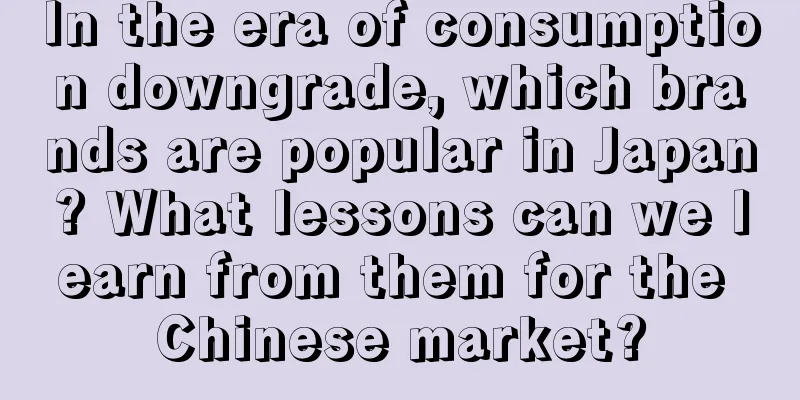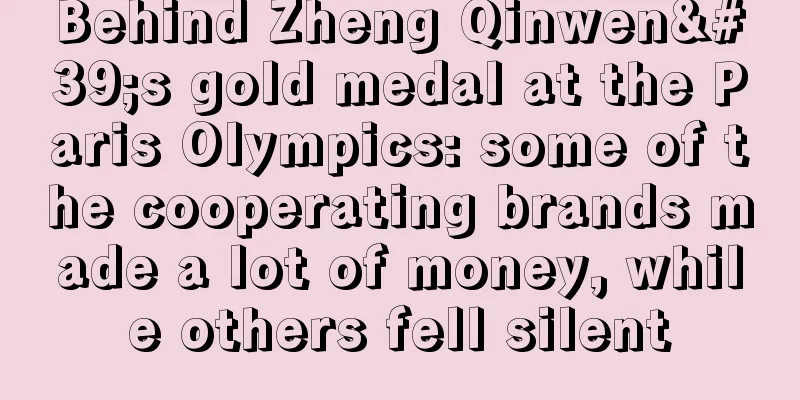In the era of consumption downgrade, which brands are popular in Japan? What lessons can we learn from them for the Chinese market?

Recently, more and more hot topics point to consumption downgrade. For example, Jack Ma said that he would return to Taobao. This is Alibaba's move to adapt to the economic downturn and try to meet consumers' demand for price and cost performance, in order to cope with the competition from low-price platforms such as Pinduoduo. For example, "Heytea and Nayuki are not popular anymore." Heytea and Nayuki used to be the representatives of consumption upgrading, but nowadays, social consumption habits have changed. Consumption downgrade makes consumers pay more attention to cost performance and practicality, and are unwilling to spend money on expensive and highly replaceable products. Now that Luckin Coffee and Kudi Coffee are available for 9.9 yuan, who is willing to spend 30 yuan on a cup of milk tea? For example, Citywalk is popular all over the Internet. Citywalk is actually a low-cost way of traveling. You can get the experience and benefits of traveling without spending too much money, but it is a travel choice with consumption downgrade. To put it bluntly, if you have money to go abroad, who would be willing to Citywalk in your own city? Various signs show that consumption downgrade is becoming more and more obvious. Of course, this situation is not unique to China. Japan, as a country that has experienced consumption downgrade in advance, has a lot to say. 1. Japan’s consumption downgradeAfter the first oil crisis, Japan's economy was in a period of low growth (the lost twenty years were also during this period), with the economic growth rate falling from 9.1% (1956-1973) to 4.2% (1974-1990). After the 1990s, it has long hovered below 1%. At the same time, the birth rate also dropped from 5 to below 2, and Japan began to enter an era of de facto consumption downgrade. Since 2005, Japan has entered what Hidetoshi Miura calls the "fourth consumer society", which has the following characteristics: From private ownership to sharing consciousness. Japan itself has a trend of "Datsu-shari", which means discarding unnecessary things and letting go of possession of things. Sharing can save money. From the pursuit of famous brands to the pursuit of simplicity and leisure, the Japanese have begun to stop "conspicuous consumption", and the hot sales of basic clothes without logos are a reflection of this. Local consumer culture prevailed. In this era, Japan began to change from worshipping the European and American lifestyle to exploring the local consciousness of Japan, and the attention paid to the local, regional and common Japanese culture continued to expand. Consumption investment learning. "When consumers realize that no matter whether it is high-end brands or other things, they can no longer achieve self-uniqueness, they think they can only change themselves." Among them, the learning tendency is an important manifestation. During this period, people generally reduced their demand for luxury goods, gradually reduced "conspicuous consumption", and began to choose cheaper and more practical products. The concept of consumption downgrade has penetrated into various fields, including clothing, home furnishings, and catering, and has promoted the rise of many emerging consumption models, such as fast fashion brands, 100-yen stores, and convenience store coffee. During this period, many successful brands focusing on cost-effectiveness were born in Japan. Compared with the current situation in China, it can be predicted that China will also give birth to a number of cost-effective brands suitable for this era. 2. Don Quijote - Good Deals: High-cost-effective daily necessitiesDon Quijote was founded in 1989, just before the Japanese economic bubble burst. It is a discount store that sells a variety of goods at low prices, ranging from food, daily necessities, clothing, home appliances, toys, etc. Its goods are mainly sourced from manufacturers' tail goods, discontinued products, defective products, etc., as well as its own brand white-label products. If you go to Don Quijote for the first time, you will be shocked by its densely packed merchandise and crowds. The store displays of Don Quijote are very dense and even chaotic, giving people a feeling of treasure hunting. The promotional posters throughout the store also create an impression of low prices throughout the store. The first time I entered Don Quijote, I spent more than 2 hours shopping. Don Quijote seized the needs of Japanese consumers seeking cheap happiness and psychological comfort during the economic downturn. It has the following main features: Goods are highly practical: such as household items, personal care products, electronic products, tableware, etc. In Japan's era of consumption downgrade, consumers pay more attention to the practicality and functionality of goods rather than luxury goods or excessive pursuit of brands. Don Quijote's products meet this demand. Affordable prices: Don Quijote controls product costs and keeps prices low by adopting efficient procurement and supply chain management to attract more consumers, which meets the demand of consumers for affordability in the era of consumption downgrade in Japan. Reliable quality: Although Don Quijote's products are relatively low-priced, they still focus on reliable quality and provide a good consumer experience. They ensure that the quality of the goods sold meets consumer expectations through cooperation with suppliers and strict quality control. In 2021, Don Quijote's total sales were 1831.28 billion yen and operating profit was 88.688 billion yen, making it the fourth largest retail company in Japan in terms of revenue. In China, a similar brand is Haotemai, a discount retail brand store mainly selling near-expiry food and daily chemicals. It has opened more than 500 stores in 32 cities across the country. At present, Haotemai has completed five rounds of financing and plans to open 2,000 stores by 2023, with an annual turnover of nearly 3 billion. Haotemai was established not long ago, and it happened to hit the era of consumption downgrade and people's demand for cost-effective products. You can buy Yuanqi Forest for 3 yuan and Australian red wine for 50 yuan. These are products of some big brands, but the prices are only 20%-50% of the original price. Consumers know that they are buying near-expiry products, but compared with non-expiry products, they have a higher cost-effectiveness and can satisfy consumers' current happiness. It’s too early to say whether Haoteimai can achieve the success of Don Quijote, but judging by its brand positioning, the merchandise it offers, and its prices, it can be said to be the brand most likely to become Don Quijote. 3. Daiso 100-yen store-MINISO: cost-effective department storeDaiso 100-yen store was founded in 1977. When Hirotake Yano started the business, he used mobile carts to sell goods. Since he had to work and take care of his children, he decided to set the price of all goods at 100 yen in order to save the work of labeling. This kind of store with an average price of 5 or 6 yuan is very popular in Japan. Although the prices of some products have increased later, the mentality of 100 yuan and good quality at a low price has been deeply rooted in people's hearts. In addition to the favorable prices, Daiso 100-yen stores also do a very good job in terms of product richness, including daily necessities, tableware, stationery, decorations, etc. The store has a wide variety of products, covering all aspects of consumers' daily lives. And these products focus on practicality and functionality, pursuing a balance between cost-effectiveness and practicality. This allows consumers to buy products with certain quality and functionality at a relatively low price. There is reason to suspect that the 2-yuan stores in various small cities in China were inspired by Daiso's 100-yen stores. These small stores sell daily household items at a uniform price of 2 yuan (some slightly higher). These 2-yuan stores sprang up in China at the end of the last century, but at that time there was no brand like Daiso's 100-yen stores in the country. MINISO can be said to be an advanced version of the 2 yuan store. The categories sold by MINISO include daily necessities, cosmetics, toys, stationery, food, digital products, etc. Its products are characterized by low prices, high cost performance and fashionable designs. The average unit price in the third quarter of fiscal year 2022 was 18.4 yuan, which is very consistent with the characteristics of commodities in the era of consumption downgrade, with low prices and strong practicality. As of March 31, 2022, MINISO has a total of 5,113 stores in China and abroad, with total revenue reaching RMB 2.34 billion in the third quarter of fiscal year 2022. In terms of business form and sales categories, MINISO can be called the Daiso 100-yen store in China. 4. Uniqlo - UR, Hotwind, Heilan Home: simple, cheap, and decent qualityAfter the economic bubble burst, Japanese consumers began to seek simplicity, practicality and economy, and their attitude towards most products changed to being good enough. They no longer flocked to brands, but turned to products that, although not branded, were sufficient and of good quality. After entering the fourth consumer era, the Japanese began to stop "conspicuous consumption" because they are not very enthusiastic about owning things, and the hot sales of basic clothes without logos are a reflection of this. When I first went to Japan, I saw Japanese people on the streets and subways seemed to be particularly keen on wearing black and white clothes. You can't tell what brand these clothes are, and there are very few so-called "dopamine outfits". Uniqlo is obviously such a brand without a logo. Their clothes are generally simple in style, with basic styles as the main categories, such as shirts in spring and autumn, sweaters in winter, T-shirts in summer, etc., and you can buy a piece of clothing with decent quality and good style for an average price of several hundred yuan. When you come to Uniqlo, you can close your eyes and pick a few pieces without choosing. You don’t have to spend too much time and energy to buy a few pieces of clothes that fit you well and are not expensive. In 2013, Uniqlo changed its brand slogan from Made For All to LifeWear. In the TVC "Why Wear" launched by Uniqlo, Uniqlo no longer emphasized the texture and technology of fabrics, but talked about lifestyle. As an impressionistic advertisement, the clothing concept it put forward at the end is "simple, high-quality and beautiful". "Simple, high-quality and beautiful" is the best pursuit in the era of consumption downgrade. In today's China, I think a brand like UNIQLO will be born in the future. At present, fast fashion brands such as UR, Heatwind, and Heilan Home have such a development trend. For example, URBAN REVIVO, a Chinese fast fashion brand founded in 2006, has more than 300 stores worldwide and annual sales of over 5 billion. Its product line is very complete, from men's and women's clothing to accessories, and to shoes and boots, and the price is not expensive. It uses the same OEM factory as UNIQLO, for example, its jeans are all made by Shenzhen Jichang Meite. For example, Hotwind, founded in 1996, has an annual revenue of over 10 billion yuan, has opened nearly 2,000 stores in China, and was listed on the main board of the Hong Kong Stock Exchange on December 10, 2021. At Hotwind, you can quickly pick out some basic clothes, or you can buy products that are very similar to big brands at a lower price. For example, you can buy Timberland or Redwing-like shoes for one or two hundred dollars. For example, HaiLan Home, which has been very popular in recent years, also sells basic clothes with simple styles and affordable prices. Its annual revenue has already exceeded 10 billion yuan. In comparison, HaiLan Home has more stores in the sinking market. The above are just some examples. Although their positioning is similar to Uniqlo, they are different from Uniqlo, and no fast fashion brand has an absolute advantage in China. Compared with Uniqlo, their history is not long, and it can be understood that they are still in the process of development. With the changes in the economic situation, perhaps a Chinese Uniqlo will evolve. 5. Convenience store coffee - Luckin Coffee, Kudi Coffee: Low-priced drinks are kingIf you have been to Japan, you will find that the most popular coffee in Japan is not Starbucks, but the coffee in various convenience stores, such as 711, Lawson, and FamilyMart, which all have their own brands of coffee. In 2019, the sales volume of freshly ground coffee in Japanese convenience stores was about 1.15 billion cups, which shows how popular this coffee is in Japan. Convenience coffee has the following characteristics: First, it is cheap, generally between 150 and 200 yen, which is just over 10 yuan in RMB. Second, it is easy to buy coffee. You just need to choose the type you want on the self-service coffee machine and press the corresponding button. It is very convenient and fast, and you don’t need to queue up like in Starbucks. Third, the most important thing is that although the coffee is cheap, the quality is not bad. Convenience stores use fully automatic coffee machines and high-quality coffee beans and milk. A cup of convenience store coffee is no worse than other brands that are twice as expensive. Therefore, convenience store coffee can fully meet the needs of office workers who don’t want to spend too much money but can buy freshly ground coffee. There are also convenience store coffee shops in China, but their development is not as good as in Japan. The main reason is that chain coffee brands such as Luckin Coffee and Kudi occupy a large part of the convenience store coffee market. Before Luckin Coffee came out, Starbucks was of course the most popular coffee brand because there were no other good choices at the time. After Luckin Coffee appeared, it quickly seized the market with a price less than half that of Starbucks coffee. Now, it has become a better choice in the era of consumption downgrade. The price of more than ten yuan, the quality of freshly ground coffee is not bad, and it can also be delivered, which meets the needs of many white-collar workers in the workplace. As a result, many people in the workplace have switched from Starbucks to Luckin. After the emergence of Kudi Coffee, the market was dragged into a bloody sea. Its price of 9.9 yuan made many people quickly become its customers, and also brought the freshly ground coffee market into the era of less than 10 yuan. In the era of consumption downgrade, consumers also pursue cost-effectiveness in their demand for coffee. Coffee is a high-frequency consumer product. A single consumption may not seem expensive, but if consumed every day, the cost throughout the year is not low. If there is a choice of cost-effective freshly ground coffee, and the quality is not too bad, then consumers will inevitably tend to choose it. Although convenience store coffee has a certain market in China, in the long run, their position has basically been occupied by brands such as Luckin Coffee and Kudi Coffee. 6. Gachapon-blind box: low-cost entertainment and leisure happinessBy the 1990s, Japan's economy had entered a long period of recession, with asset bubbles bursting, stock market crashes, property prices plummeting, and the real economy in a slump. GDP growth continued to hover at a low level, often with zero growth or even negative growth. The Japanese income level also fell by nearly 20%. In this context, Japanese capsule toys have become a cheap and enjoyable way of consumption. On the one hand, the price of capsule toys is relatively low, usually between 100-500 yen, which will not cause too much burden even if you are in financial difficulties. On the other hand, there is a certain psychological satisfaction in the game of gashapon games. Consumers can gain a sense of accomplishment and belonging by collecting their favorite series or characters. For people whose reality is not so satisfactory, they bring psychological comfort and become a way to relieve stress. According to statistics, the sales of capsule toys in Japan reached about 20 billion yen in 1994, increased to about 30 billion yen in 1995, and exceeded 40 billion yen in 1996. In China, blind boxes are even more popular than capsule toys. Both products are based on two-dimensional culture such as toys, animation, and games, and take advantage of consumers' curiosity and gambling mentality to encourage them to continue consuming and repurchasing. At first glance, the higher price of blind boxes seems to have little to do with consumption downgrade, but due to its gambling, addiction and decompression mechanism, it is actually related to people's psychological needs. When the economy is bad, people need more entertainment to relieve their negative emotions and stress. Lottery tickets, capsule toys and blind boxes all have this function. They relax themselves and relieve themselves by buying these things. 7. What did Japan’s consumer downgrade brands do right?Brands that have risen in the era of consumption downgrade have grasped the consumption trends under consumption downgrade, made targeted business and market strategies, and ultimately won consumers. 1. Reliable quality and high cost performanceIn the era of consumption downgrade, consumers no longer believe that the more expensive the better when purchasing goods. Instead, they want to buy brands that are more suitable for them, have high cost-effectiveness, strong practicality and reliable quality. Brands like Uniqlo, by adopting the SPA (specialty retailer) model, have achieved integrated management from design, production to sales, reducing costs and allowing consumers to buy cost-effective clothing. MUJI reduces costs and lowers the prices of its products by removing unnecessary packaging, labels and advertisements. But high cost-effectiveness and low price are not the same thing. Consumers expect products to have high cost-effectiveness and good quality. They hope to get good value for money. A set of clothes from Uniqlo costs 200 or 300 yuan, but the quality is guaranteed. Compared with the goods that cost dozens of yuan at street stalls, it has a huge advantage. Although the prices of goods in Daiso 100-yen stores are low, they are also relatively durable and will not break after two uses like those of goods purchased from unknown sources. 2. Satisfy the concept of practicality, health, environmental protection and no logoIn the era of consumption downgrade, consumers' demand for conspicuous consumption is gradually declining. They have shifted from blindly pursuing external factors such as brands, luxury, and showing off to pursuing internal factors such as practicality, health, and environmental protection. The most typical representative of them is MUJI. MUJI means good products without brand logos in Japanese. The brand name gives people a "Buddhist" feeling. It is characterized by providing simple, natural, environmentally friendly and high-quality products, satisfying consumers' yearning for a simple life. MUJI design consultant Kenya Hara used a phrase to explain the concept of MUJI products, "It's not necessary, it's good like this" and "It's good like this". This can be said to reflect the brand concept of MUJI, which does not need a LOGO to show identity, but rather rational consumption. 3. Cooperate with virtual characters to provide spiritual satisfactionConsumers have become "Buddhist" in the era of consumption downgrade, but this does not mean that they have no spiritual pursuits. In this era, they often hope that some small surprises and small happiness can bring them spiritual comfort. This is also the reason why virtual characters or industries such as animation, two-dimensional, and games are so popular in this era. In this era, successful brands often collaborate with well-known IPs to bring new surprises to consumers and meet their expectations. For example, UNIQLO has launched many joint series by collaborating with well-known designers and brands, such as Jil Sander, Lemaire, KAWS, etc., which has enhanced its brand image and appeal. Daiso 100-yen store has collaborated with well-known IPs such as Disney, Doraemon, and Sanrio to launch various products with these popular characters as themes, such as cosmetics, towels, coin purses, mobile phone cases, etc. These products are not only brightly colored but also of high quality, meeting the needs of many consumers who like Japanese cute things. In the era of consumption downgrade, Gachapon also takes toys, animation, games and other two-dimensional culture as its main content, which encourages them to consume and helps them relieve stress. 8. ConclusionDon’t waste any crisis. The era of consumer downgrade is a disaster for some brands, but it may be an opportunity for others. If brands can accurately grasp the changes in consumer demand and provide products and services with high cost performance, strong practicality, reliable quality and spiritual satisfaction, they may be able to succeed in such an era. As Churchill said: “Don’t waste any crisis. Author: Xunkong, WeChat public account: Xunkong’s Marketing Revelation |
<<: Answers to "difficult and complicated" questions on Xiaohongshu
>>: Fans surge! WeChat "Ask a question", a must-do traffic outlet in 2023
Recommend
Are there any restrictions on foreign exchange settlement by enterprises? What should I do if there are restrictions?
In today's globalized world, companies often n...
The county town has changed, and young people have changed their minds
Coffee shops, script-killing games... my hometown ...
Does Amazon have a Double 11? What are some shopping tips?
Amazon is a cross-border e-commerce platform. Dome...
Where is the eBay Seller Center? What functions does it have?
The current development of the eBay platform is qu...
Taobao and JD.com both cancel pre-sales during 618 promotion: the big promotion begins to enter a cooling-off period
Every year, pre-sale seems to be an indispensable ...
48 days to go before the Paris Olympics, marketing styles at home and abroad are differentiated
The most anticipated sporting event, the 2024 Pari...
New trends in instant retail in 2024: Forward warehouses will become the mainstream, surpassing stores
This article deeply analyzes the new trends in the...
5 ways to activate consumer needs
Do you know enough about "demand"? In fa...
How to boost sales on Shopee? How to increase sales?
For Shopee merchants, it is necessary to pay atten...
How do you play the local life services that platforms must compete for?
Meituan’s adjustments have caused major brands to ...
Taking Haidilao as an example, we explore the core differences between traditional industries and the Internet
"Haidilao doesn't look at the rate of neg...
Entrepreneurs must learn to make money within their own cognition first
The author of this article has summarized a common...
10,000 words of practical information: User growth can be so simple (40 pictures)
I believe everyone may have had this feeling in th...
How does Amazon add variations? How many variations can I add?
On the Amazon platform, adding variations means co...
Reviewing 7 major brand cases that broke the circle at the World Cup and how sports marketing will be played in the future
This year's World Cup has come to an end, but ...









